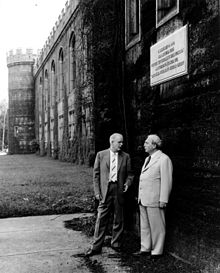Norman Hilberry
| Norman Hilberry | |
|---|---|

Norman Hilberry (left) with Leo Szilard at Stagg Field
|
|
| Born | Horace van Norman Hilberry March 11, 1899 Cleveland, Ohio |
| Died | March 28, 1986 (aged 87) Phoenix, Arizona |
| Citizenship | American |
| Fields | Physics |
| Institutions |
New York University Argonne National Laboratory University of Arizona |
| Alma mater |
Oberlin College, A.B. University of Chicago Ph.D. |
| Thesis | Extensive cosmic-ray showers and the energy distribution of the primary cosmic rays (1941) |
| Known for | Director of Argonne National Laboratory |
Norman Hilberry (March 11, 1899 – March 28, 1986) was an American physicist, best known as the director of the Argonne National Laboratory from 1956 to 1961. In December 1942 he was the man who stood ready with an axe to cut the scram line during the start up of Chicago Pile-1, the world's first nuclear reactor to achieve criticality.
Horace van Norman Hilberry was born in Cleveland, Ohio, on March 11, 1899. He received his Bachelor of Arts (A.B.) degree from Oberlin College in 1921, and then became an assistant in physics at the University of Chicago. In 1925 he became an instructor in physics at Washington Square College in New York, where he rose to become an assistant professor in 1928. He earned his Doctor of Philosophy (Ph.D.) from the University of Chicago in 1941, writing his thesis on "Extensive cosmic-ray showers and the energy distribution of the primary cosmic rays".
In 1941, Hilberry joined what would become the Manhattan Project, the effort to create an atomic bomb during World War II. He moved to the University of Chicago to help Arthur H. Compton in any way possible. Hilberry became associate director of Compton's Metallurgical Project. On December 2, 1942, he was present for the start up of Chicago Pile-1, the world's first nuclear reactor to achieve criticality. Because of fears that the reaction could "run away", Hilberry stood ready with an axe to cut the scram line, a manila rope connected to control rods that could quickly shut the reactor down. He was also present for the start-up of the X-10 Graphite Reactor in November 1943, and the reactors at the Hanford Engineer Works the following year. He returned to the Metallurgical Laboratory in Chicago in 1945.
...
Wikipedia
